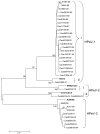Human parechovirus types 1, 2 and 3 infections in Canada
- PMID: 16707054
- PMCID: PMC3373051
- DOI: 10.3201/eid1206.051675
Human parechovirus types 1, 2 and 3 infections in Canada
Abstract
A new reverse transcription-polymerase chain reaction assay was developed for identification of 28 Canadian human parechovirus (HPeV) isolates, including 20 HPeV-1, 3 HPeV-2, and 5 HPeV-3, recovered from 1985 to 2004. All HPeV-1 isolates but 1 were genetically distinct from the Harris reference strain. One HPeV-2 isolate was related to the Williamson strain; the other 2 were related to the Connecticut strain. HPeV-3 isolates clustered together. Seventy-five percent of isolates were recovered during the typical enterovirus season. All patients but 1 were children with a mean age of 14.6 months, 6.3 months, and 0.7 months for HPeV-1, HPeV-2, and HPeV-3 patients, respectively. All HPeV-2- and HPeV-3-infected children were hospitalized with a diagnosis of viremia or sepsis. HPeV-1- infected children had bronchiolitis diagnosed in 50% of the cases, with few cases of pneumonia and enteritis. Two infected patients (1 child with leukemia and a 78-year-old woman) died of septic shock and severe pneumonia, respectively.
Figures



References
-
- King AMQ, Brown F, Christian P, Hovi T, Hyypia T, Knowles NJ, et al. Family Picornaviridae. In: van Regenmortel MHV, Fauquet CM, Bishop DHL, Carstens EB, Estes MK, Lemon SM, et al., editors. Virus taxonomy. San Diego: Academic Press; 2000. p. 657–78.
MeSH terms
Substances
LinkOut - more resources
Full Text Sources
Other Literature Sources
